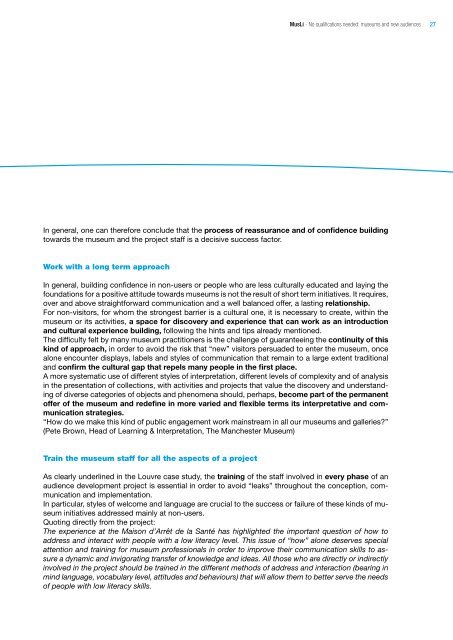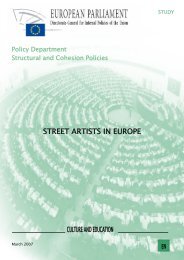MusLi (Museums Literacy) - Fondazione Fitzcarraldo
MusLi (Museums Literacy) - Fondazione Fitzcarraldo
MusLi (Museums Literacy) - Fondazione Fitzcarraldo
You also want an ePaper? Increase the reach of your titles
YUMPU automatically turns print PDFs into web optimized ePapers that Google loves.
<strong>MusLi</strong> - No qualifications needed: museums and new audiences<br />
In general, one can therefore conclude that the process of reassurance and of confidence building<br />
towards the museum and the project staff is a decisive success factor.<br />
Work with a long term approach<br />
In general, building confidence in non-users or people who are less culturally educated and laying the<br />
foundations for a positive attitude towards museums is not the result of short term initiatives. It requires,<br />
over and above straightforward communication and a well balanced offer, a lasting relationship.<br />
For non-visitors, for whom the strongest barrier is a cultural one, it is necessary to create, within the<br />
museum or its activities, a space for discovery and experience that can work as an introduction<br />
and cultural experience building, following the hints and tips already mentioned.<br />
The difficulty felt by many museum practitioners is the challenge of guaranteeing the continuity of this<br />
kind of approach, in order to avoid the risk that “new” visitors persuaded to enter the museum, once<br />
alone encounter displays, labels and styles of communication that remain to a large extent traditional<br />
and confirm the cultural gap that repels many people in the first place.<br />
A more systematic use of different styles of interpretation, different levels of complexity and of analysis<br />
in the presentation of collections, with activities and projects that value the discovery and understanding<br />
of diverse categories of objects and phenomena should, perhaps, become part of the permanent<br />
offer of the museum and redefine in more varied and flexible terms its interpretative and communication<br />
strategies.<br />
“How do we make this kind of public engagement work mainstream in all our museums and galleries?”<br />
(Pete Brown, Head of Learning & Interpretation, The Manchester Museum)<br />
Train the museum staff for all the aspects of a project<br />
As clearly underlined in the Louvre case study, the training of the staff involved in every phase of an<br />
audience development project is essential in order to avoid “leaks” throughout the conception, communication<br />
and implementation.<br />
In particular, styles of welcome and language are crucial to the success or failure of these kinds of museum<br />
initiatives addressed mainly at non-users.<br />
Quoting directly from the project:<br />
The experience at the Maison d’Arrêt de la Santé has highlighted the important question of how to<br />
address and interact with people with a low literacy level. This issue of “how” alone deserves special<br />
attention and training for museum professionals in order to improve their communication skills to assure<br />
a dynamic and invigorating transfer of knowledge and ideas. All those who are directly or indirectly<br />
involved in the project should be trained in the different methods of address and interaction (bearing in<br />
mind language, vocabulary level, attitudes and behaviours) that will allow them to better serve the needs<br />
of people with low literacy skills.<br />
27






